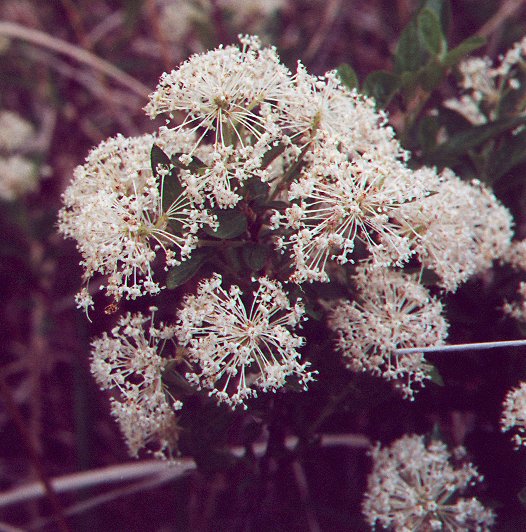Ceanothus herbaceus Raf.
Redroot

Native
CC = 8
CW = 5
MOC = 27
© DETenaglia
Ceanothus herbaceus Raf.Redroot | |
 |
Native CC = 8 CW = 5 MOC = 27 |
© DETenaglia |
|
Family - Rhamnaceae Habit - Shrubs, to 1 m. Stems - Erect with ascending branches, woody, multiple from base, sparsely pubescent. New growth pubescent, green. Leaves - Alternate, petiolate, stipulate. Stipules 4.5 mm long, 1 mm broad, pubescent. Petioles to 7 mm long, pubescent. Blades 1-6 cm long, 0.5-2.0 cm broad, elliptic to lanceolate, angled to rounded at the base, usually bluntly pointed, toothed, the upper surface sparsely to moderately pubescent with short, somewhat cobwebby hairs, rarely glabrous, the undersurface moderately to densely short-hairy, rarely glabrous or nearly so.
Inflorescence - Terminal on the main branchlets of the present year's growth, relatively short-stalked, the inflorescence stalk to 2 cm, generally shorter than the subtending leaf. Pedicels white, to 1.4 cm long, 0.6 mm in diameter, expanding just below hypanthium. Flowers - Sepals 5, 0.5-1.0 mm long, white, glabrous. Petals 5, 1.5-2.5 mm, white, long clawed, spreading, glabrous. Limb to 1.2 mm broad, cupped. Stamens 5, opposite petals, erect. Filaments to 2 mm long, white, glabrous. Anthers 0.2 mm long, yellow. Style 3-lobed, 2 mm long, glabrous, white. Ovary 3-locular, green, surrounded by peringynous disk. Hypanthium white, 1 mm long, persistent.
Fruits - Capsulelike, modified drupes, with 3 lobes and 3 stones, 4-5 mm broad, the outer surface thin, leathery, black, not glaucous, the stones dehiscing explosively at maturity, tearing open the outer fruit layers and expelling the seeds. Seeds 1.5-2.0 mm long, more or less obovate in outline, somewhat anglar, the surface smooth, reddish brown to brown, shiny.
Flowering - April - June. Habitat - Upland and rocky prairies, loess hills, glades, rocky woods. Origin - Native to U.S. Lookalikes - Ceanothus americanus. Other info. - This plant occurs mostly in the western half of Missouri but is uncommon. Its main distribution is in the Great Plains states to our west. It is easily recognized, although it could be confused with the far more common C. americanus. That species has more ovate leaves, more cylindric inflorescences, and longer peduncles. Photographs taken at the James C. McCormack Conservation Area, Holt County, MO., 5-3-00 and 6-30-00. |